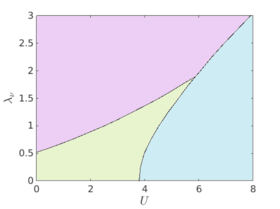DFT+DMFT methods for strongly-correlated systems
Whenever standard density functional theory fails because of strong correlations, the dynamical mean-field theory comes into play. This theory, developed in the early nineties, is one of the most successful approaches for describing strongly-correlated systems and Mott transitions.
We work on up-to-date implementations of the DFT+DMFT framework, constantly implementing new features into our code packages that are released as the TRIQS/DFTTools application. At the moment there is an interface to the Wien2k band structure code, and several DMFT solvers and post-processing tools.
Relevant Publications:
- Dynamical Mean-Field Theory within an Augmented Plane-Wave Framework: Assessing Electronic Correlations in the Iron Pnictide LaFeAsO
M. Aichhorn, L. Pourovskii, V. Vildosola, M. Ferrero, O. Parcollet, T. Miyake, A. Georges, and S. Biermann, Physical Review B 80, 085101 (2009). - Importance of electronic correlations for structural and magnetic properties of the iron pnictide superconductor LaFeAsO
M. Aichhorn, L. Pourovskii, and A. Georges, Physical Review B 84, 054529 (2011). - TRIQS/DFTTools: A TRIQS application for ab initio calculations of correlated materials
M. Aichhorn, L. Pourovskii, P. Seth, V. Vildosola, M. Zingl, O. E. Peil, X. Y. Deng, J. Mravlje, G. J. Kraberger, C. Martins, M. Ferrero, and O. Parcollet, Comp. Phys. Comm. 204, 200-208 (2016).
Spin-Orbit Coupling, Topology, and Strong Correlations
- Reduced Effective Spin-Orbital Degeneracy and Spin-Orbital Ordering in Paramagnetic Transition-Metal Oxides: Sr2IrO4 versus Sr2RhO4
C. Martins, M. Aichhorn, L. Vaugier, and S. Biermann, Phys. Rev. Lett. 107, 266404 (2011). - Topological insulator on honeycomb lattices and ribbons without inversion symmetry
R. Triebl and M. Aichhorn, Phys. Rev. B 94, 165169 (2016).
Ab initio prediction of a two-dimensional variant of the iridate IrO2
A. Smolyanyuk, I.I. Mazin, M. Aichhorn, and L. Boeri
Fork Tensor Product States - Efficient Three Orbital Real Time DMFT Solver
Daniel Bauernfeind, Manuel Zingl, Robert Triebl, Markus Aichhorn, Hans Gerd Evertz
Search for high-Tc conventional superconductivity at megabar pressures in the lithium-sulfur system
Christian Kokail, Christoph Heil, Lilia Boeri

